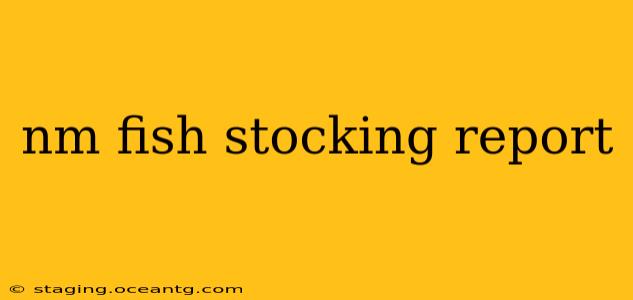New Mexico's diverse landscape supports a variety of fish species, and the New Mexico Department of Game and Fish (NMDGF) plays a crucial role in maintaining healthy fish populations through a robust stocking program. This report provides a comprehensive overview of the NM fish stocking program, addressing common questions and providing valuable insights for anglers and conservationists alike.
What is the NM Fish Stocking Program?
The NM fish stocking program is a crucial component of the NMDGF's fisheries management strategy. It involves strategically introducing fish into various water bodies across the state to enhance recreational fishing opportunities, restore native populations, and maintain biodiversity. This program isn't about simply throwing fish into lakes; it's a carefully planned operation based on extensive research, habitat assessments, and population monitoring. The NMDGF considers factors such as water quality, existing fish populations, and angler demand before deciding which species to stock and in what quantities.
What species of fish are stocked in New Mexico?
The NMDGF stocks a variety of species, tailored to the specific needs of each water body. Common stocked species include:
- Trout: Rainbow trout, brown trout, and cutthroat trout are frequently stocked, especially in high-elevation lakes and streams. These species are highly popular with anglers.
- Warmwater Fish: Species like largemouth bass, channel catfish, and bluegill are stocked in lower-elevation reservoirs and ponds, providing opportunities for different fishing styles.
- Native Species: The NMDGF also focuses on restoring native fish populations through selective breeding and stocking programs where appropriate. This is crucial for maintaining the state’s unique aquatic biodiversity.
What lakes and rivers are stocked in New Mexico?
The NMDGF stocks numerous lakes and rivers across the state. The specific locations and stocking schedules vary depending on the species, water conditions, and overall management objectives. The most up-to-date information on stocking locations is available on the NMDGF website. Their interactive map is an excellent tool for anglers to find nearby stocked waters.
How often are New Mexico waters stocked?
Stocking frequency depends on several factors, including the species, water body characteristics, and the success of previous stockings. Some waters are stocked annually, while others may receive fish less frequently. Again, consult the official NMDGF website for the most current stocking schedule information.
Where can I find the NM fish stocking report?
The detailed NM fish stocking report is usually available on the NMDGF website. This report provides specifics on the species, numbers of fish stocked, and locations. It often includes details about the size and age of the stocked fish, providing valuable information for anglers to anticipate their fishing success.
How can I get involved in the NM fish stocking program?
While the stocking itself is managed by the NMDGF, there are many ways to support their efforts. You can participate in angler surveys, volunteer for habitat restoration projects, or become a member of organizations that support fisheries conservation in New Mexico. Supporting these organizations financially also directly contributes to their crucial work.
What are the benefits of fish stocking?
Fish stocking offers numerous benefits, including:
- Enhanced Recreational Fishing: Stocking programs increase fishing opportunities for anglers of all skill levels.
- Economic Benefits: Recreational fishing generates significant revenue for local communities through tourism and related businesses.
- Conservation of Native Species: In some cases, stocking can help to restore or augment native fish populations that may have declined due to habitat loss or other factors.
By implementing a comprehensive and science-based approach to fish stocking, the NMDGF plays a vital role in the conservation and management of New Mexico's diverse aquatic resources. Regularly checking the NMDGF website for updated reports and information is essential for both anglers and those interested in the state's conservation efforts.
